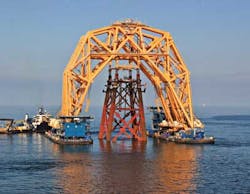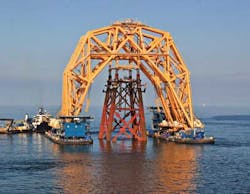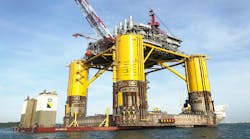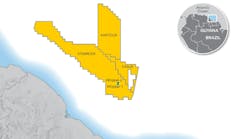Specialized vessel completes first full season of GoM work
Peter Devine
Versabar
Offshore decommissioning is growing more complex and challenging. At the same time as work depths increase, the recovery targets get heavier, and the configurations of the targets on the seabed become more difficult to manage.
Specialized equipment can help. One example is Versabar'sVB 10000. With its first full recovery season just ended, the projects it tackled indicate the direction decommissioning is likely to take in the future.
Deployed in October 2010,VB 10000 is the largest lift vessel ever built in the United States. It performed two significant lifts in the abbreviated 2010 campaign, and her operators looked forward to a full season of lift operations in 2011.
The first order of business before starting work in 2011 was to commission a DP-3 system for the10000. The Class 3 DP system consists of four 1,000-hp azimuthing thrusters in each of the system's two barges. Freed of the mooring constraints of the Bottom Feeder, the VB 10000 should be able to perform complex on-site maneuvers, and, more significantly, to operate in water depths more than 35 ft (10.5 m).
Once work began, the vessel performed 40 lift operations of widely differing scope and nature from May 24 to Nov. 5. Several of these projects illustrate the new challenges faced in decommissioning.
Ten toppled decks were retrieved from the sea floor, and three standing decks were removed as were three standing jackets. Two toppled jackets also were retrieved. In a procedure first performed by theVB 10000's predecessor, the Bottom Feeder, two of the jackets were towed and reefed.
The initial lift operation on May 24 was a dual operation. Each of theVB 10000's two gantries was employed simultaneously, one retrieving a 500-ton debris basket while the other lifted a 250-ton deck skid. This job marked the operational introduction of the DP-3 capability of the vessel.
After removing a decommissioned topside from its jacketVB 10000 took on its most challenging lift to date. The object was a 228-ft (70-m) long, 100-ft (30.5-m) wide, 3,200-ton topside that was toppled from its jacket by Hurricane Ivan. The topside had reached the sea floor sideways and embedded itself 40 ft (12 m) below the mud line. This required that it be retrieved from the mud and brought to the surface in that same vertical position, a test not only of the vessel's lifting capacity, but also of its available hook-height.
These challenges were met and the topside was placed on a barge outfitted with 450 tons of custom-engineered grillage for stable transport to shore. Extracting the topside from the mud incurred loads of up to 6,000 tons.
On July 5, another standing topside, complete with flare boom and helideck, was removed. This is typical of the preference for single-piece removal. Two weeks later the vessel undertook another ground-breaking endeavor, making using of its multiple main hoist blocks to grapple with a sunken 3,000-ton topside to reposition it on the sea floor, in order to be able to correctly place lift slings to raise it in an inverted fashion. Again, the vessel's available hook-height of 175 ft (53 m) was valuable.
Early in 2011, Versabar engineers began design drawings for a radically different set of underwater lift elements. Nicknamed the "Claw," the matching set of 122-ft-tall (37-m-tall) grappling devices each weighs 1,100 tons, and is designed to operate in much the same way as the small plastic jaws used to fish for prizes in toy arcades. Once lifted from the sea floor by the Claw, topsides are placed on custom-engineered steel cradles previously installed for that purpose, and the entire package then is brought to the surface.
On Sept. 16-17, the cradles were set on the sea floor. TheVB 10000 then returned to her Sabine Pass berth to change out rigging. It returned to the lift site on the morning of Sept. 21. Working without pause, the VB 10000 and her crew maneuvered through the debris field to scoop up ruined topsides with the Claw. Ninety-six hours later, five topsides were on barges heading for Gulf Coast salvage yards.
October featured two jacket removals. The vessel lifted the jackets, transported them in an upright position to their designated reefing sites, and, working with tugboats, toppled them into the sea. Each jackets' buoyant weight was 4,000 tons.
The lift season concluded Nov. 5 with one last lift of a standing topside. From float-over to transport barge sail-away, theVB 10000 team typically performs these operations in eight hours or less.
With that, the largest US flagged lift vessel returned to her berth for routine maintenance and upgrades in preparation for the 2012 lift season.
Offshore Articles Archives
View Oil and Gas Articles on PennEnergy.com






